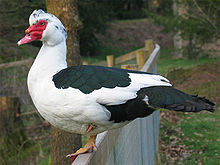This article needs additional citations for verification. (November 2016) |
The Muscovy or Barbary is the domesticated form of the wild Muscovy duck, Cairina moschata. There are a number of local or regional breeds, and drakes of these are commonly cross-bred with domestic ducks to produce the hybrids called mulards.
 A white-headed black magpie drake | |
| Conservation status | GEH (2023): Cat. IV: Watch[1] |
|---|---|
| Other names | Barbary |
| Use | Meat, Cross-breeding |
| Traits | |
| Weight |
|
| Classification | |
| EE | Yes[2] |
| |
History
editThe Muscovy had been domesticated by various indigenous peoples of the Americas well before the arrival of Christopher Columbus in 1492.[3]: 463
Characteristics
editDomestic Muscovy drakes weigh some 4.5–6.3 kg. The duck is much smaller, typically about half the size of the drake, with a weight of 2.3–3.2 kg.[3]: 466
Recognised colour varieties include five solid colours – black, blue, chocolate, lavender and white[3]: 465 – and eight 'magpie' colours, in which the whole back from the tail to the shoulders and the underside from below the tail to the breast is coloured black, blue, chocolate or lavender, the remainder being white. In the standard magpie colourings the crown of the head is also coloured; in the white-headed magpie colours the head is white.[3]: 466
Use
editThe Muscovy is commonly reared for meat.[4]: 78
In commercial production, it is often crossed with a mallard-derived domestic duck such as the Rouen or Pekin to produce the hybrid known as a mulard.[4]: 97 These hatch in about four weeks and grow rapidly like a mallard-type duck, but to about the size and weight of the Muscovy.[4]: 97 The inverse cross – domestic drake with Muscovy duck – is also possible, but infrequent.[4]: 97 [5] The mulard is reared both for its meat and for its liver, much of it as foie gras.[5] The mulard is considered kosher in Jewish dietary law.[5]
References
edit- ^ Rote Liste Geflügelrassen (in German). Gesellschaft zur Erhaltung alter und gefährdeter Haustierrassen. Archived 31 October 2023.
- ^ Liste des races et variétés homologuée dans les pays EE (28.04.2013). Entente Européenne d'Aviculture et de Cuniculture. Archived 16 June 2013.
- ^ a b c d J. Ian H. Allonby, Philippe B. Wilson (editors) (2018). British Poultry Standards: complete specifications and judging points of all standardized breeds and varieties of poultry as compiled by the specialist breed clubs and recognised by the Poultry Club of Great Britain, seventh edition. Chichester; Hoboken, New Jersey: Wiley Blackwell. ISBN 9781119509141.
- ^ a b c d Dave Holderread (2001). Storey's Guide to Raising Ducks. Pownal, Vermont: Storey Books. ISBN 9781580172585.
- ^ a b c Zivotofsky, Rabbi Ari Z.; Amar, Zohar (2003). "The Halachic Tale of Three American Birds: Turkey, Prairie Chicken, and Muscovy Duck". Journal of Halacha and Contemporary Society. 6: 81–104.